Amazon is causing a stir among grocery retailers by building brick-and-mortar locations to compete with Walmart, Aldi, and other chains in the curbside-pickup and grocery-delivery markets. Billed as convenience stores, these outlets will sell fresh items such as milk, produce, and meat, as well as many non-perishables, leveraging mobile and other technology to make shopping fast and easy for customers.
Until recently, Amazon has been content to stay out of the grocery market because of thin margins and other complexities. To win in the grocery space, sellers need ample repeat purchases, and traditional grocers already saturate neighborhoods where shoppers visit at least once per week in part because they like to select their own produce and meats. In fact, 80 percent of the country lives within 2.5 miles of a supermarket. Further, no one is sure when or if online grocery shopping will catch on. Several companies — WebVan, PeaPod, Walmart, and Amazon Fresh — have tried for years to change consumer habits, yet only 2 to 4 percent of food and beverages are bought online today (Bloomberg).
Changes Ahead
That said, experts say a tipping point could be close, particularly for younger demographics, where half of those surveyed recently said they bought or planned to buy groceries online (Bloomberg). Amazon’s grocery model may also leverage the Amazon Prime membership, which attracts repeat purchases from customers who want to justify the $99 annual fee. This is no small thing. Researchers found that Prime members spent an average of $1,500 at Amazon.com in 2014, compared to non-members who spent about $625 (The Huffington Post).
The grocery market is highly fragmented, which leaves grocery retailers concerned about how to fight the “category-killing” Amazon. Despite the costs, some retailers are considering home delivery because they lack options to fight extinction, but the logistical challenges are huge. Keeping food cold requires expensive refrigeration methods and tight delivery windows, particularly in warm weather. And the problem worsens when customers are not home to accept deliveries, causing drivers to idle or drive around, wasting time and fuel (The Wall Street Journal).
A Potential Solution
For many grocers, the “click and collect” model may be the answer because it carries less risk than delivery services. Also known as BOPIS (“Buy Online, Pickup In Store”), the model is working for mega-retailer Walmart, which plans to expand to more than 1,100 stores in 80 markets over the next year or two.
To compete effectively, grocery retailers must:
1. Offer a meaningful omni-channel experience
- Become one store with brick-and-mortar and online benefits, instead of two distinct offerings
- Engage users of smart phones with targeted content, including product promotions and recommendations
- Leverage tools such as beacon technology and consumer apps like Shopkick
- Install Wi-Fi and kiosks in stores to help shoppers order with ease
- Equip employees with tablets or other technology to help consumers special-order items or ship those not in stock
2. Maximize existing strengths
- Tout the benefits of shopping in-person, including the ability to smell and touch produce, select fresh seafood from the case, taste samples, or even socialize with local employees
- Focus on convenience by offering accessible locations, practical pick-up times, and staffing for speed
- Emphasize locally farmed and sourced products, or unique items customers can’t get elsewhere (Time)
Amazon’s foray into brick-and-mortar stores has made traditional retailers pause. But the move also affirms the need for physical stores and for many reasons. No matter the success of Amazon’s strategies, grocery retailers who understand what modern consumers want, and provide realistic options to meet their needs, will stay relevant and profitable in the future.

